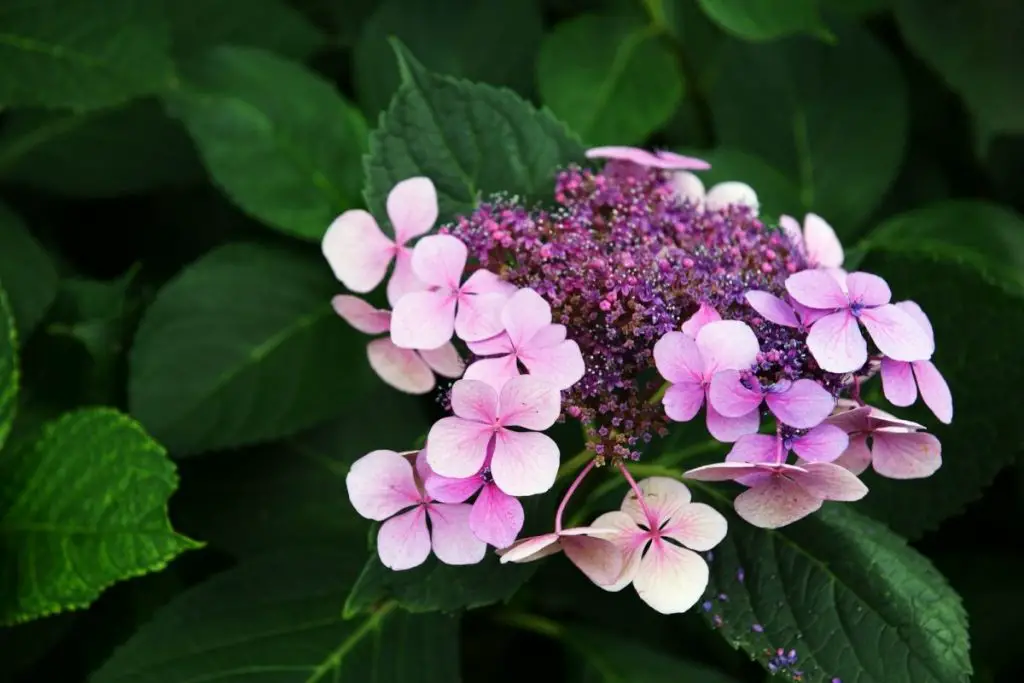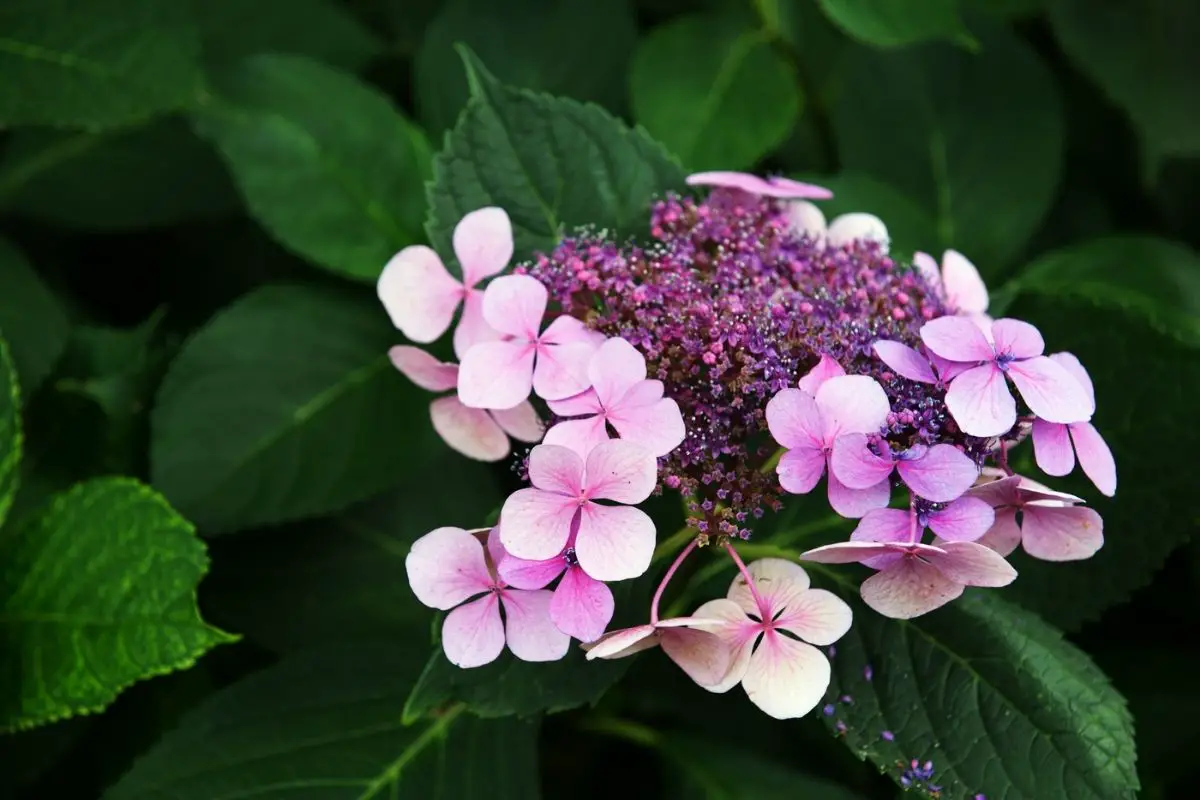The Hydrangea Serrata shrub bears much resemblance to the widely grown Hydrangea Macrophylla, but it is a more compact shrub and won’t grow more than around 4 feet (1.22 m) in either direction.
If you have suitable soil, this perennial shrub can make a lovely addition to your garden due to its pretty, long-lasting summer flowers and low maintenance requirements.
Because this plant is native to northern Japan, it is more winter hardy than some other varieties of hydrangea shrubs.
The deciduous H. serrata bush bears its name from the serrated shape of its dark green leaves.
History
This plant species used to be classified with the lacecap hydrangeas (H. macrophylla) because of the similarities in the form of the flower heads.
Plant Facts
| Scientific name | Hydrangea serrata |
| Common names | Tea of Heaven, Mountain Hydrangea |
| Genus | Hydrangea |
| Family | Hydrangeaceae |
| Height | 2 to 4 feet (1.22 m) |
| Width | 2 to 4 feet (1.22 m) |
| USDA Plant Hardiness Zone | Zones 6 to 9 |
| Origin | Japan, Korea |
| Flower colors | Pink, blue, white |
| Blooming season | Summer |
| Plant/Flower special features | Flower color can be changed from pink to blue by adjusting the alkalinity/acidity of the soil |
How to Plant and Grow Mountain Hydrangeas
Because of its small size, this hydrangea is ideal to grow if you have limited space. Mountain hydrangeas can be planted in containers or in a mixed flower bed.
It is important to remember that this is a hydrangea that originates from the cooler mountainous regions of Japan and therefore prefers cooler conditions than the more commonly grown mophead or lacecap hydrangeas.
When you are choosing a planting site, try to find somewhere that is sheltered from the prevailing wind, in order to prevent the soil around the hydrangea from rapidly drying out.

Care and Maintenance
When it comes to growing hydrangeas, here are the requirements:
Soil
You need to make sure that you plant mountain hydrangea shrubs in soil that drains well. This hydrangea species however is more tolerant of heavy soil than other macrophylla varieties.
Hydrangea shrubs prefer slightly acidic soil, but if you change the acidity levels, you can change the color of your blossoms. A soil pH level above 7 will result in pink flowers, and below 6.5, blue flowers.
Water
Like other hydrangeas, H. serrata prefers soil that is damp, but which has good drainage.
Fertilizer
Applications of slow-release fertilizer are best applied during the spring or early summer, just before flowering. Hydrangea fertilizer has a specialized composition that is high in phosphorus which will encourage new growth and good blooms.
Some hydrangea fertilizers include a pH adjuster, which you can use if you want to keep blue flowers blue or change your pink flowers to blue.
Sunlight
Sunlight is important if you want to see the best flower production from your mountain hydrangea shrub. However, this species is more tolerant of full sun than H. macrophylla, provided it receives adequate water. If you have low rainfall, then the H. serrata should be protected from the full sun during the hottest part of the day.
Temperature and Humidity
This species is hardy down to USDA zone 6 and if you provide some winter protection, it can be grown in USDA zone 5 too.
During its period of winter dormancy, this hydrangea shrub can survive very cold temperatures. But, late frosts or extended periods of cold in the spring can lead to damage to flower buds, resulting in a deficit of flowers in the following summer.
Pruning
This lovely shrub grows in a tidy, mounded shape. Any pruning needs to be done immediately after the flowers have finished flowering. This is because most varieties of H. serrata flower on old wood, and the plant needs time to produce its buds before the arrival of winter dormancy. There are some newer cultivars that flower on both old and new wood, leading to an increased flowering season.
Repotting and Transplanting
If you decide to repot a container-grown plant, make sure you find a large pot that is about 3 inches (7.62 cm) larger than the existing root ball.
Transplanting a soil-grown shrub is a more delicate process and should only be carried out in fall or very early spring. The weather is cooler then, and the soil damp, which will avoid stressing the plant when it is transplanted.
The mountain hydrangea bush is deciduous, so there won’t be any leaves on the shrub when you are moving it. It can be less labor-intensive to replant your hydrangea in the fall since there will be less need for regular hand watering during the winter than in the summer.
Prepare the new planting site before you dig up the existing hydrangea bush. The hole should be about three times the size of the existing root system to give the plant plenty of space to spread out its roots. You should add some well-rotted, organic compost to the soil and mix it in well. There should also be soft, crumbly soil at the edges of the planting hole. Water the hole so that it will be drained, but moist when you replant the hydrangea.
It is important that you carefully dig around the plant because you want to protect as many hydrangea’s roots as possible. Dig out as much main root ball as you can to avoid causing damage to its roots. Place the plant in the prepared hole, taking care to untangle and spread out its roots. It should not be planted too deeply. Once you have checked the hydrangea is straight, you can backfill, and add a mulch around the plant base. Water it again.
Keep an eye on your newly transplanted shrub to make sure it doesn’t dry out. This is particularly important during the first season after the hydrangea has been moved.
Pests and diseases
This tooth-leaved hydrangea doesn’t suffer from many diseases or pest problems. Aphid infestations, if they do occur at the height of the summer, aren’t likely to adversely affect the plant. Sometimes they can be removed by hand, or eliminated by a powerful jet of water from a garden hose. Aphids can be more prevalent on new growth.
To avoid blight or other fungal diseases taking hold, it is important that the mountain hydrangea plant doesn’t sit in waterlogged soil. If your soil is particularly heavy, then improve the drainage and condition the soil.
Prevention is better than cure, so try to keep your hydrangea bushes as healthy as possible. Always remove any dead or decaying foliage and water at the base of the plant, not from overhead.
Mountain hydrangeas aren’t deer-resistant plants. Although deer may damage mountain hydrangea leaves, they prefer native hydrangea species such as oakleaf hydrangea or tree hydrangea.
How to Propagate
This hydrangea species can be propagated by seed, but results are unreliable and slow. It is much better to take stem cuttings that are around 4 inches (10.16 cm) in length. You want to select healthy softwood stems, remove all but the top pair of leaves and cut these in half sideways.
The use of hormone rooting powder is optional, but it will speed up the process of obtaining well-rooted, strong plants. Dip the tip of the stems in the rooting powder and insert them into a moist, clean compost or similar growing medium.
Your cuttings should be protected from direct sunlight but should be kept warm in a well-lit environment. Keep the cuttings damp, but do not let them get waterlogged, or they will rot and die.
Uses of Hydrangea Serrata
Newer mountain hydrangea cultivars are everblooming and can flower for up to 30 weeks of the year if given the best growing conditions. This long season of flowering interest has resulted in a greatly renewed interest in this showy garden or container-grown shrub. The flowers can be of the showy mophead or the more delicate lacecap type.
The serrated hydrangea leaves contain a natural sweetener. In Japan, these leaves are used to make Amacha herbal tea. This infusion, which is very sweet, is drunk on special occasions and to celebrate the birth of Buddha. Amacha tea contains no caffeine and negligible calories despite its sweet taste.
Common Varieties and Cultivars
There are several hydrangea cultivars that have achieved the Royal Horticultural Society’s Award of Garden Merit.
H. serrata “Preziosa”
This is a great gardener’s choice and a compact shrub which is packed with flowers from early summer to fall. The flowers start off green, progress to yellow, then from cream to white. As they start to fade, they continue to change color to pink, then red, and finally to a deep burgundy. This is a naturally occurring color progression and isn’t dependent upon any adjustment of the soil pH level.
H. serrata “Bluebird”
In addition to a profusion of delicate lacecap flowers which can measure up to 8 inches (20.32 cm) in diameter in summer, this deciduous hydrangea has beautiful red leaves in fall.
H. serrata “Bluebird” will grow to a maximum height and spread of 4 feet (1.22 m). It can be planted in the ground or in a container. It is an easy-to-grow shrub that suffers little from pests or diseases. The flowers can be changed from pink to blue by adjustment of the soil’s pH level.
H. serrata “Tuff Stuff”
This reblooming and long-flowering, deciduous shrub is cold hardy to grow in USDA zones 5 to 9. This is a mountain hydrangea type that will tolerate more shade than many other varieties. It is a very small, rounded bush, only growing to a maximum height and spread of 2 feet (0.61 m).
Conclusion
These tooth-leaved hydrangea shrubs offer all the spectacular summer display provided by the commonly grown H. macrophylla, but on a compact plant that is more cold tolerant.
Look out for one of the prize-winning, reblooming cultivars, and you will have even longer to enjoy the showy blooms.
~ image source: depositphotos/nad.loboda.gmail.com

